A New Insight on the Upwelling along the Atlantic Iberian Coasts and Warm Water Outflow in the Gulf of Cadiz from Multiscale Ultrahigh Resolution Sea Surface Temperature Imagery
Abstract
:1. Introduction
2. Materials and Methods
2.1. Satellite Imagery
2.2. Wind Data
2.3. The Karhunen–Loève Discret Transform or EOF on Digital Imagery
2.4. Mathematical Morphology and the Geometric Theory of the Measure
2.5. Maximum Entropy Spectral Analysis and Harmonic Prediction
3. Results and Discussion
3.1. SST Imagery of the Whole ATLAZUL Area
3.2. Area and Fractal Dimension
3.2.1. Galician–Portugal Region
3.2.2. Gulf of Cádiz Region
3.2.3. Comparison between the Two Regions
3.3. KLT/EOF Analysis
3.3.1. Galician–Portugal Region
3.3.2. Gulf of Cádiz Region
3.3.3. Comparison between the Two Regions
3.4. On the Effect of the Wind
3.4.1. Area
3.4.2. The Second and Third Modes
3.5. Prediction
3.5.1. Harmonic Model Prediction
3.5.2. Results and Discussion
4. Conclusions
Author Contributions
Funding
Institutional Review Board Statement
Informed Consent Statement
Data Availability Statement
Acknowledgments
Conflicts of Interest
References
- Haynes, R.; Barton, E.D.; Pilling, I. Development, persistence and variability of upwelling filaments off the Atlantic coast of the Iberian Peninsula. J. Geophys. Ocean. Res. 1993, 98, 22681–222692. [Google Scholar] [CrossRef]
- Pérez, F.F.; Castro, C.G.; Álvarez-Salgado, X.A.; Ríos, A.F. Coupling between the Iberian basin-scale circulation and the Portugal boundary current system: A chemical study. Deep. Sea Res. Part I Oceanogr. Res. Pap. 2001, 48, 1519–1533. [Google Scholar] [CrossRef]
- Martins, C.S.; Hamann, M.; Fiúza, F.F.G. Surface circulation in the eastern North Atlantic from drifters and altimetry. J. Geophys. Ocean. Res. 2002, 107, 3217. [Google Scholar] [CrossRef]
- Peliz, A.; Dubert, J.; Santos, A.M.P.; Oliveira, P.B.; Le Cann, B. Winter upper ocean circulation in the western Iberia basin- fronts, eddies and poleward flows: An overview. Deep Sea Res. I 2005, 52, 621–646. [Google Scholar] [CrossRef]
- Arístegui, J.; Álvarez-Salgado, X.A.; Barton, E.D.; Figueiras, F.G.; Hernández-León, S.; Roy, C.; Santos, A.M.P. Oceanography and fisheries od the Canary current/Iberian region of the eastern North Atlantic. In The Sea; Robinson, A., Brink, K.H., Eds.; Harvard University Press: Cambridge, MA, USA, 2004; Volume 14. [Google Scholar]
- Relvas, P.; Barton, E.D.; Dubert, J.; Oliveira, P.B.; Pleiz, A.; da Silva, J.C.B.; Santos, A.M.P. Physical oceanography of the western Iberia ecosystem: Latest views and challenges. Prog. Oceanogr. 2007, 74, 149–173. [Google Scholar] [CrossRef]
- Criado-Aldanueva, F.; García-Lafuente, J.; Navarro, G.; Ruiz, J. Seasonal and interanual variability of the Surface circulation in the eastern Gulf of Cádiz (SW Iberia). J. Geophys. Ocean. Res. 2009, 114, C01011. [Google Scholar] [CrossRef]
- Nolasco, R.; Cordeiro, P.; Cordeiro, N.; Le Cann, B.; Dubert, J. A high-resolution modeling study of the western Iberian margin mean and seasonal upper ocean circulation. Ocean. Dyn. 2013, 63, 1041–1062. [Google Scholar] [CrossRef]
- Serrano, M.A.; Cobos, M.; Magaña, P.J.; Díez-Minguito, M. Sensitivity of Iberian estuaries to changes in sea water temperature, salinity, river flow, mean sea level and tidal amplitude. Estuar. Coast. Shelf Sci. 2020, 236, 106624. [Google Scholar] [CrossRef]
- Alonso, J.; Blázquez, E.; Isaza, E.; Vidal, J. Internal structure of the upwelling events at Punta Gallinas (Colombian Caribbean) from MODIS-SST imagery. Cont. Shelf Res. 2015, 109, 127–134. [Google Scholar] [CrossRef]
- Alonso, J.; Vidal, J.; Blázquez, E. On the prediction of upwelling events at the Colombian Caribbean coasts from MODIS-SST imagery. Sensors 2019, 19, 2861. [Google Scholar] [CrossRef]
- Blázquez, E.; Alonso, J.; Vidal, J. On the Correlation of Sea Surface Temperature and Chlorophyll in Upwelling Events from Satellite Imagery. Oceanogr. Fish. 2017, 5, 15–18. [Google Scholar] [CrossRef]
- Blázquez, E.; Alonso, J.; Vidal, J. On the sensitivity of the fractal dimension of the skeleton of sea surface temperature signatures from upwelling events on spatial resolution and threshold: Application on imagery of the Caribbean Sea. Int. J. Remote Sens. 2017, 38, 371–390. [Google Scholar] [CrossRef]
- Hotelling, H. Analysis of a complex of statistical variables into principal components. J. Educ. Psychol. 1953, 24, 417–441. [Google Scholar] [CrossRef]
- Thomson, R.E.; Emery, W. Data Analysis Methods in Physical Oceanography, 3rd ed.; Elsevier: New York, NY, USA, 2014. [Google Scholar]
- Fukunaga, K. Introduction to Statistical Recognition; Academic Press: Cambridge, MA, USA, 1990. [Google Scholar]
- Orfanidis, S.J. Introduction to Signal Processing; Prentice Hall: Upper Saddle River, NJ, USA, 1996. [Google Scholar]
- Marple, S.L. Digital Spectral Analysis with Applications; Prentice Hall: Sydney, Australia, 1987. [Google Scholar]
- Serra, J. Image Analysis and Mathematical Morphology; Academic Press: London, UK, 1982; Volume I. [Google Scholar]
- Serra, J. Mathematical Morphology and Image Analysis; Academic Press: London, UK, 1988; Volume II. [Google Scholar]
- Soille, P. Morphological Image Analysis: Principles and Applications, 2nd ed.; Springer: Berlin/Heidelberg, Germany, 2003. [Google Scholar]
- Soille, P. Morphological Image Analysis; Springer: Berlin/Heidelberg, Germany, 2004. [Google Scholar]
- Toshio, M.C.; Vazquez, J.; Armstrong, E.M. A multi-scale high-resolution analysis of global sea surface temperature. Remote Sens. Environ. 2017, 200, 154–169. [Google Scholar] [CrossRef]
- Karhunen, K. Zur Spektraltheorie Stochastischer Prozesse; Annales Academia Science Fennicae: Helsinki, Finland, 1946; p. 37. [Google Scholar]
- Loève, M.M. Probability Theory; Van Nostrand: Princeton, NJ, USA, 1955. [Google Scholar]
- Burl, J.B. Reduced-order system identification using the Karhunen-Loève transform. Int. J. Model. Simul. 1993, 13, 183–188. [Google Scholar] [CrossRef]
- Yamashita, Y.; Ogawa, H. Relative Karhunen-Loève Transform. IEEE Trans. Signal Process. 1996, 44, 371. [Google Scholar] [CrossRef]
- Kirby, M.; Sirovich, S. Application of the Karhunen-Loève Procedure for the characterization of human faces. IEEE Trans. Pattern Anal. Mach. Intell. 1990, 12, 103–108. [Google Scholar] [CrossRef]
- Murase, H.; Nayar, S. Visual learning and recognition of 3-D objects from appearance. Int. J. Comput. Vis. 1995, 14, 5–24. [Google Scholar] [CrossRef]
- Berberian, S.K. Introduction to Hilbert Spaces; Oxford University Press: Oxford, UK, 1961. [Google Scholar]
- Abellanas, L.; Galindo, A. Espacios de Hilbert; Eudema, S.A., Ed.; Universidad Complutense de Madrid: Madrid, Spain, 1987. [Google Scholar]
- Maragos, P.; Schafer, R. Morphological filters–part I: Their Set-theoretic Analysis and Relations to Linear Shift-invariant Filters. IEEE Trans. Acoust. Speech Signal Process. 1987, 35, 1153–1169. [Google Scholar] [CrossRef]
- Mendiola-Santibáñez, J.D.; Terol-Villalobos, I.R. Morphological Contrast Enhancement Using Connected Transformations. Proc. SPIE 2002, 4667, 365–376. [Google Scholar]
- Falconer, K. The Geometry of Fractal Sets; Cambridge University Press: Cambridge, UK, 1985. [Google Scholar]
- Falconer, K. Fractal Geometry: Mathematical Foundations and Applications, 2nd ed.; Wiley: Chichester, UK, 2003. [Google Scholar]
- Peña Sánchez de Rivera, D. Análisis de Series Temporales; Alianza Editorial: Madrid, Spain, 2005; ISBN 978-84-206-9128-2. [Google Scholar]
- Vandaele, W. Applied Time Series and Box-Jenkins Models; Academic Press: Orlando, FL, USA, 1983; ISBN 0127126503. [Google Scholar]
- Alonso, J.J. On the Fractal Dimension of Earth Tides and Characterization of Gravity Stations. Bull. D’informations Marees Terr. 1998, 129, 9963–9973. [Google Scholar]
- Alonso, J.J.; Vidal, J.M.; Blázquez, E. Why Are the High Frequency Structures of the Sea Surface Temperature in the Brazil–Malvinas Confluence Area Difficult to Predict? An Explanation Based on Multiscale Imagery and Fractal Geometry. J. Mar. Sci. Eng. 2023, 11, 1096. [Google Scholar] [CrossRef]

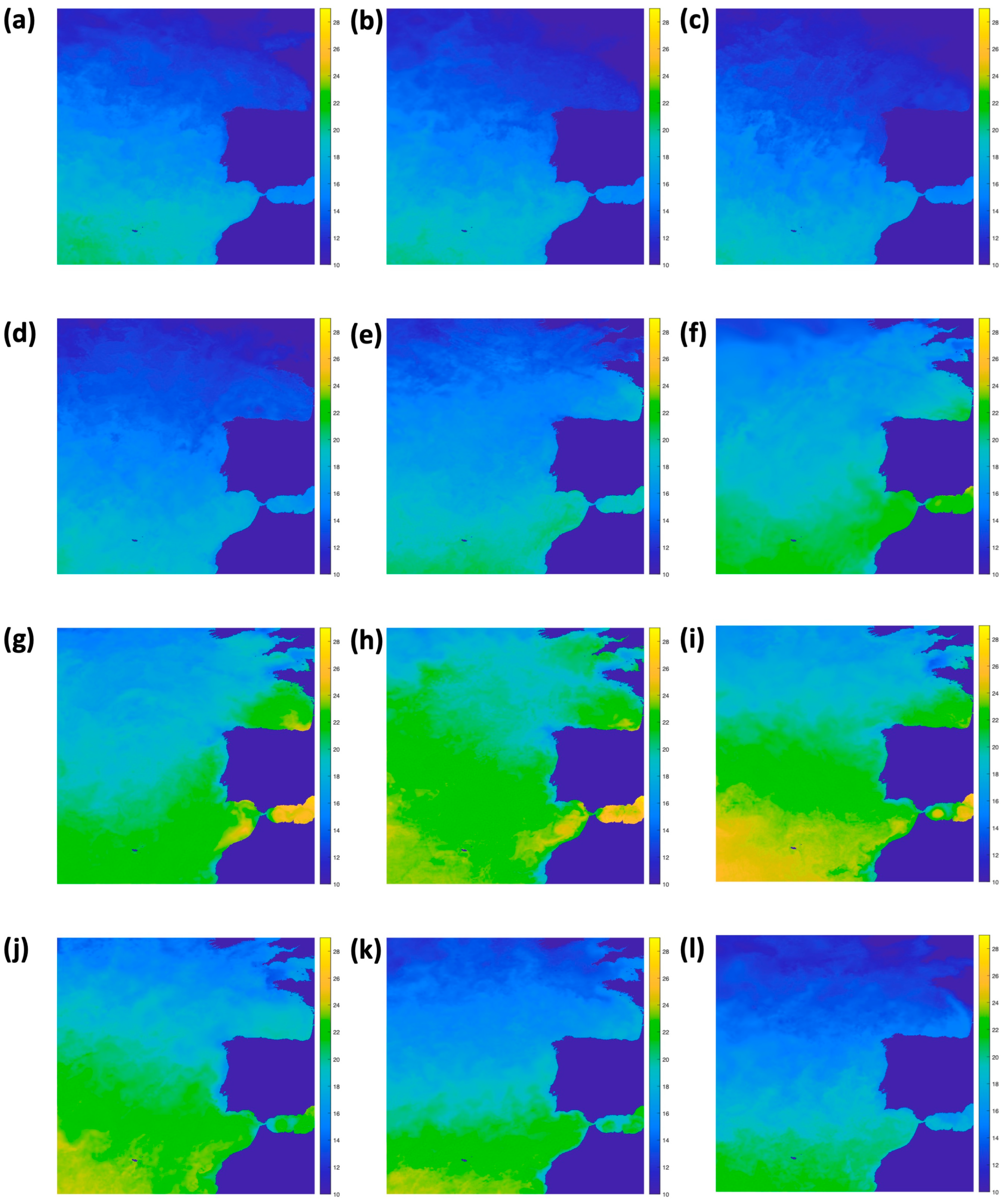

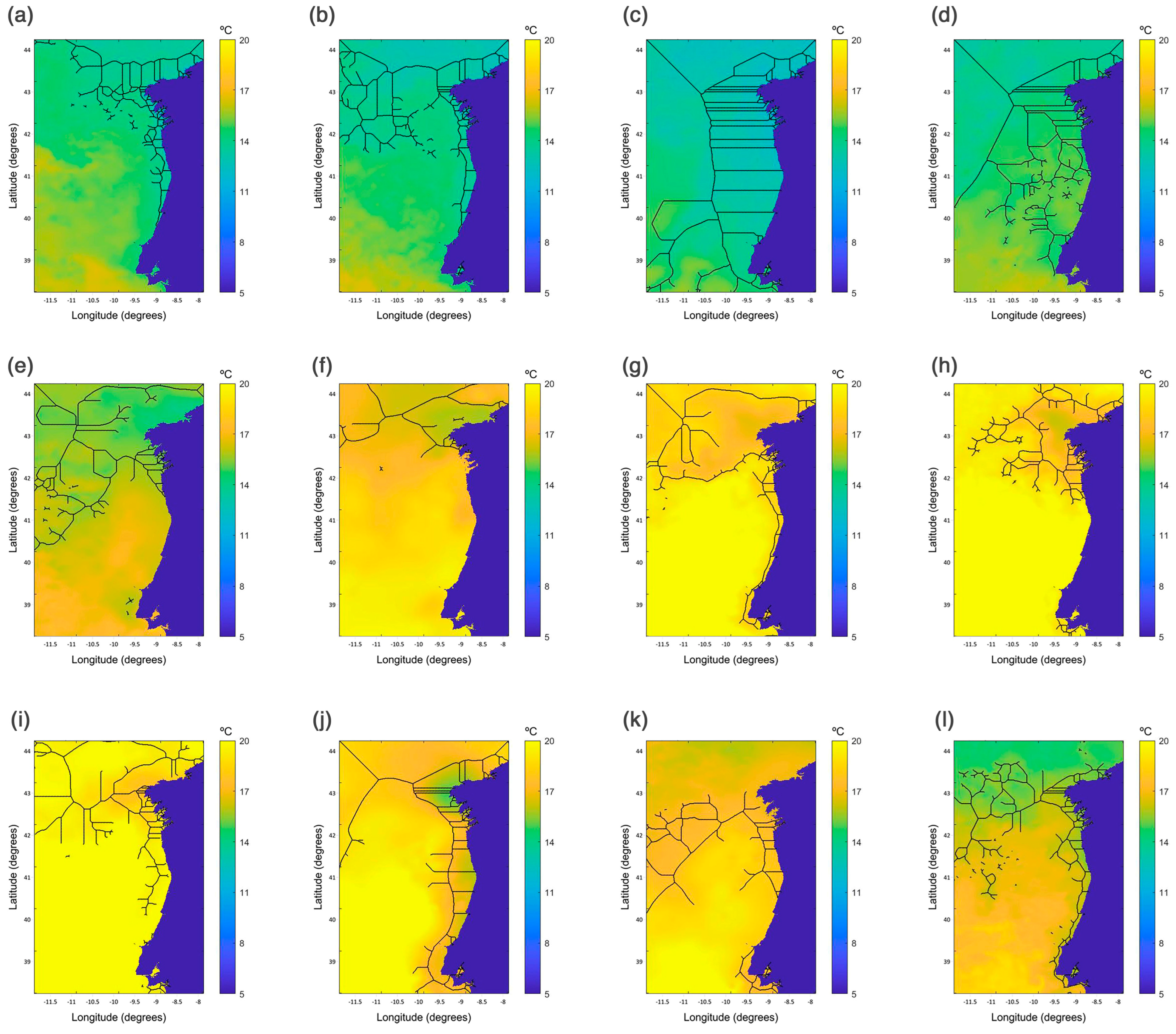


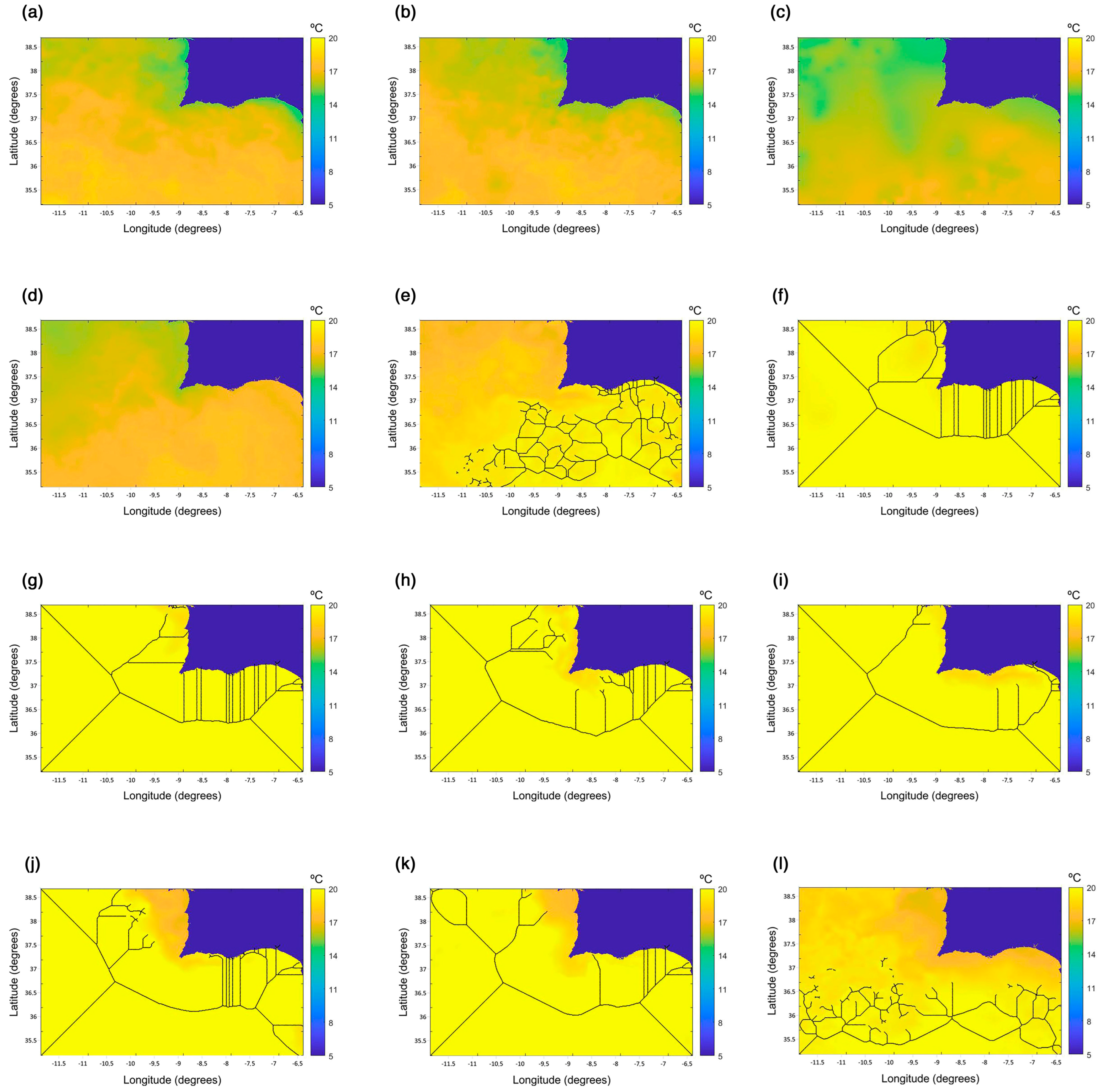

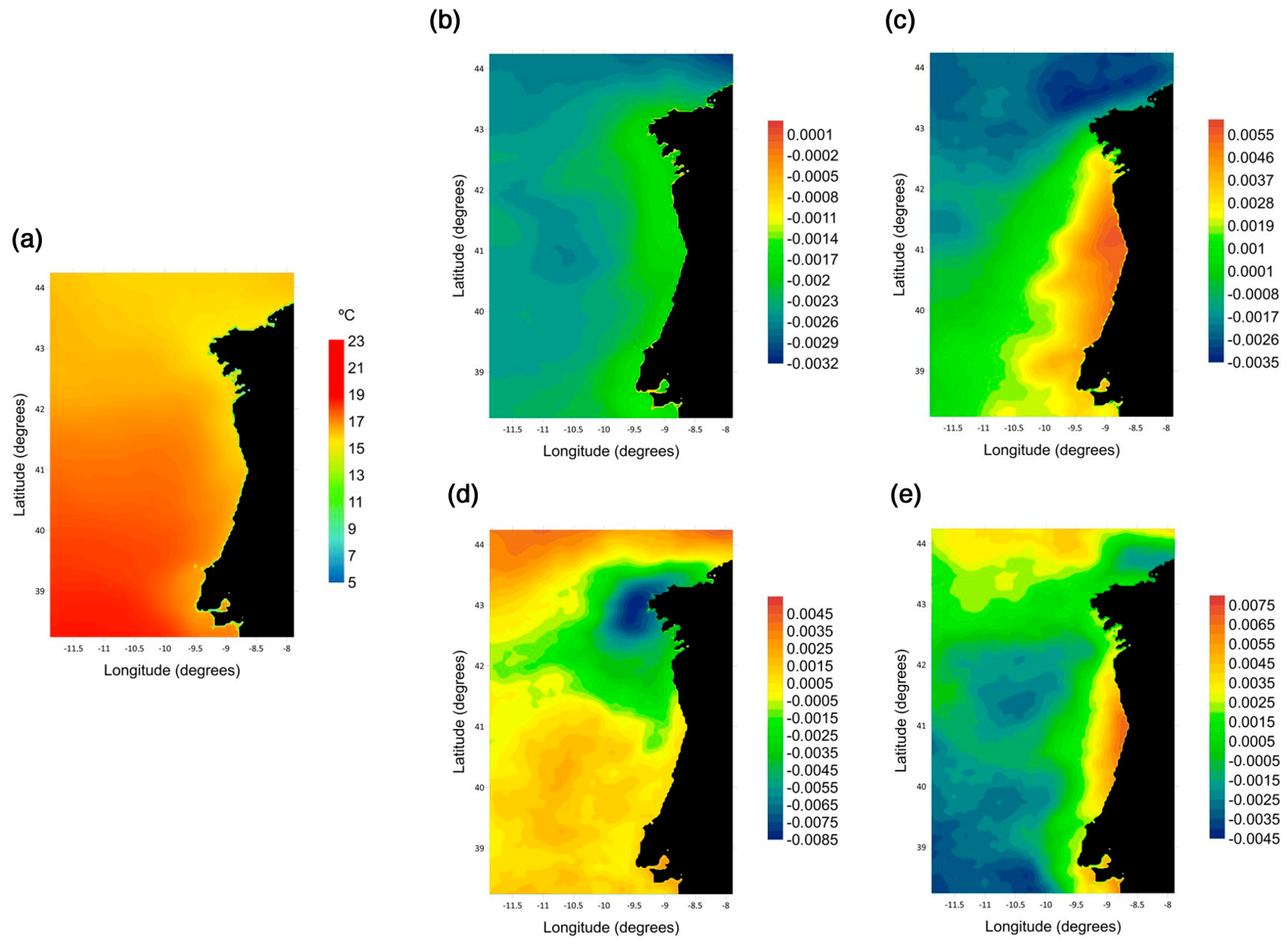

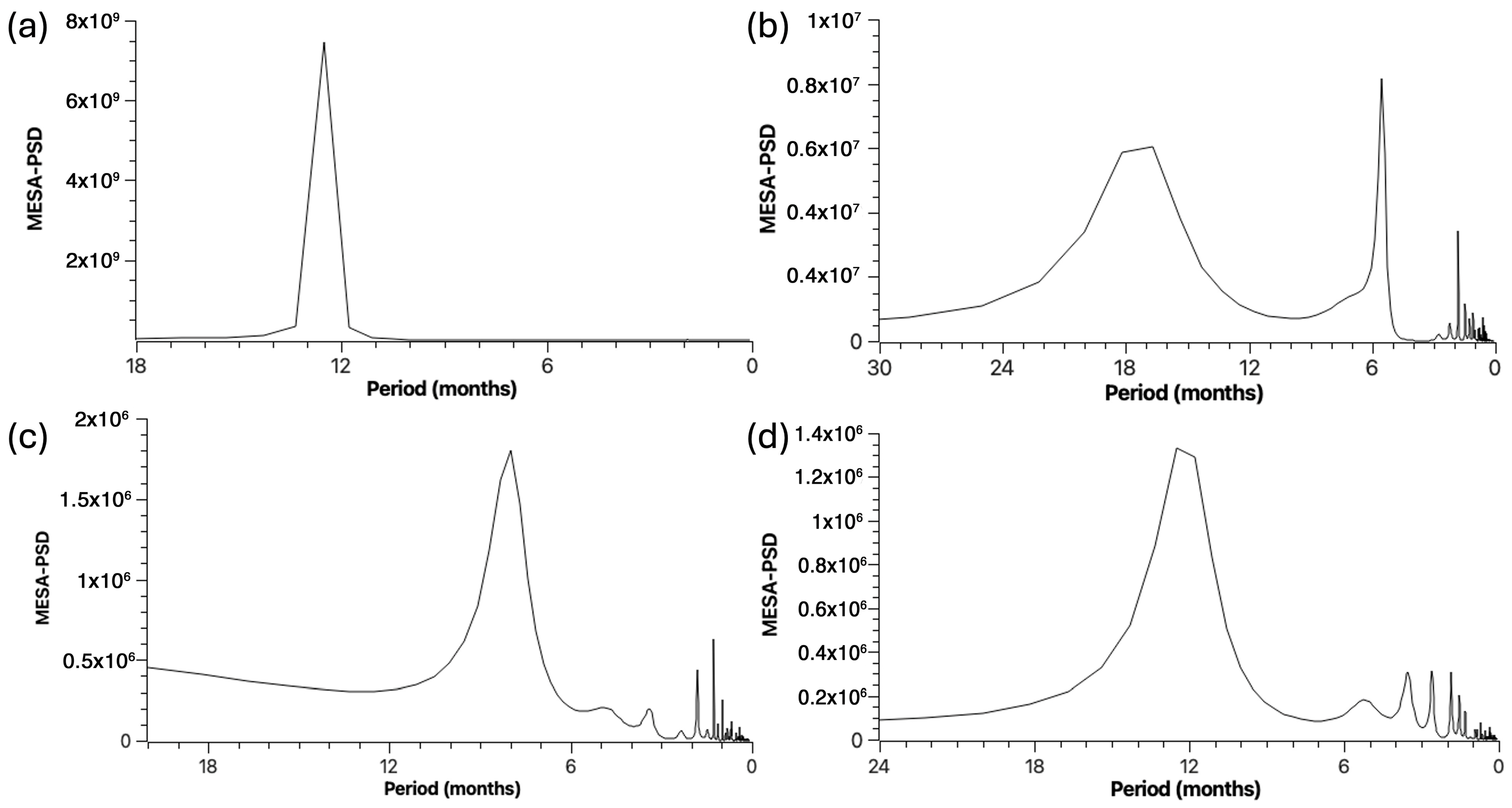
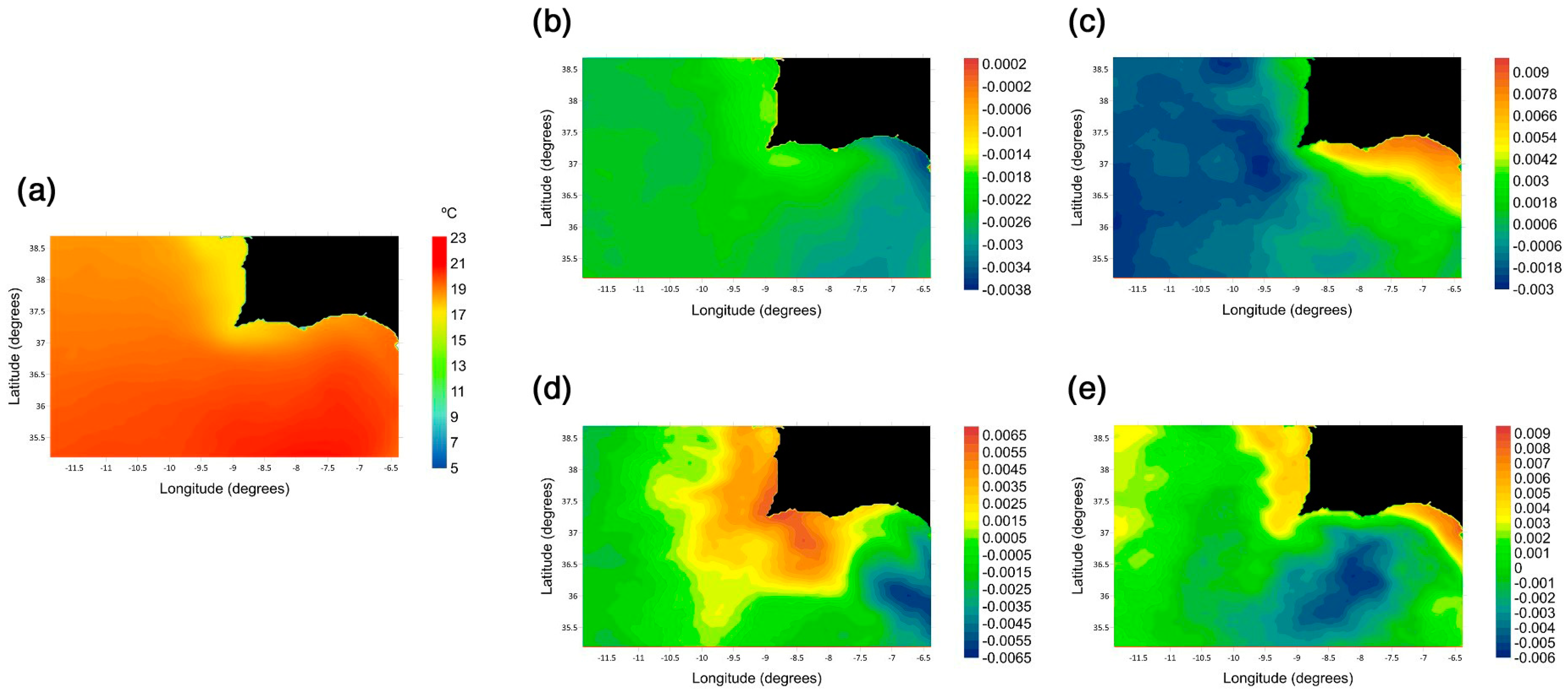

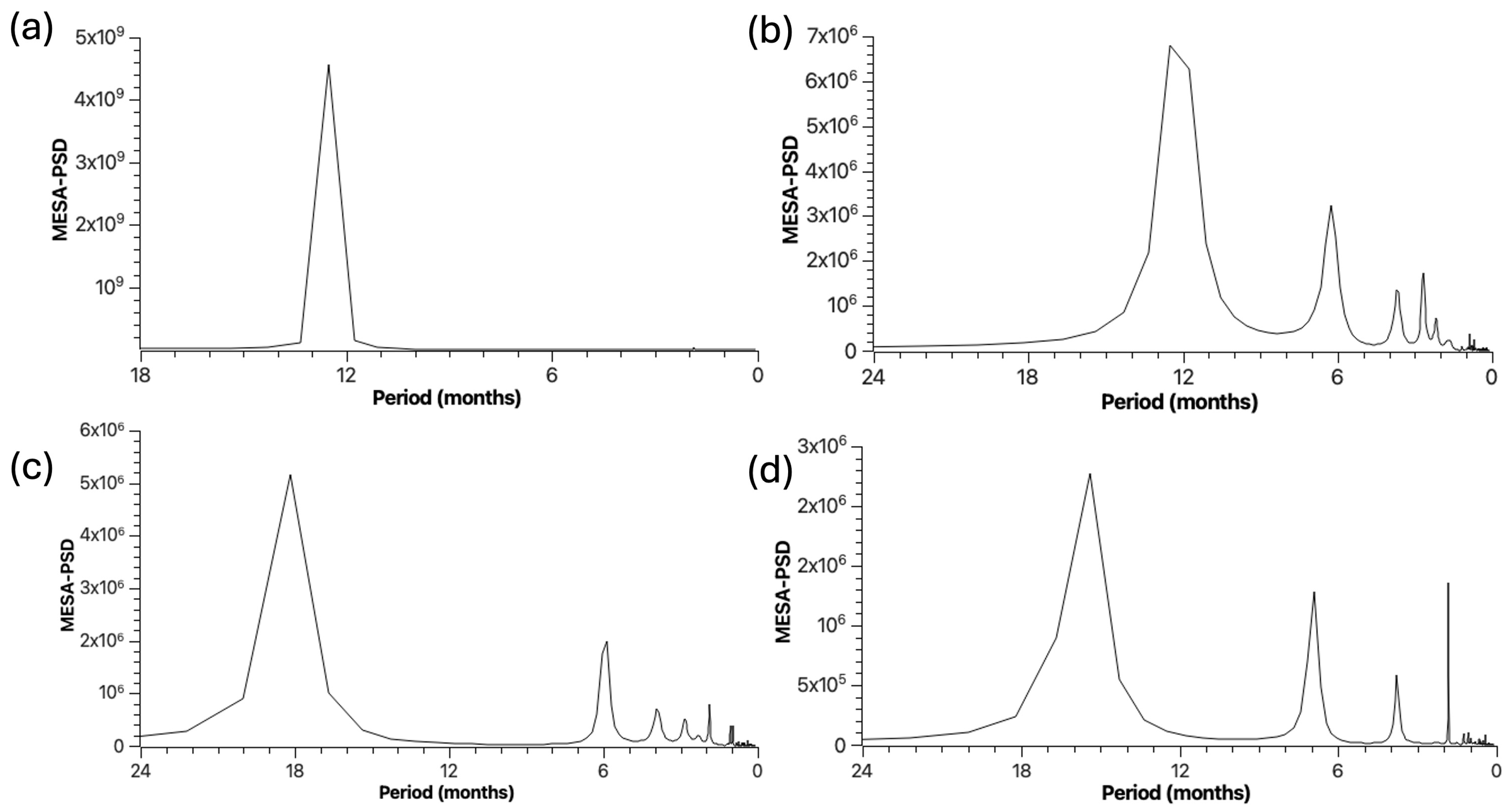
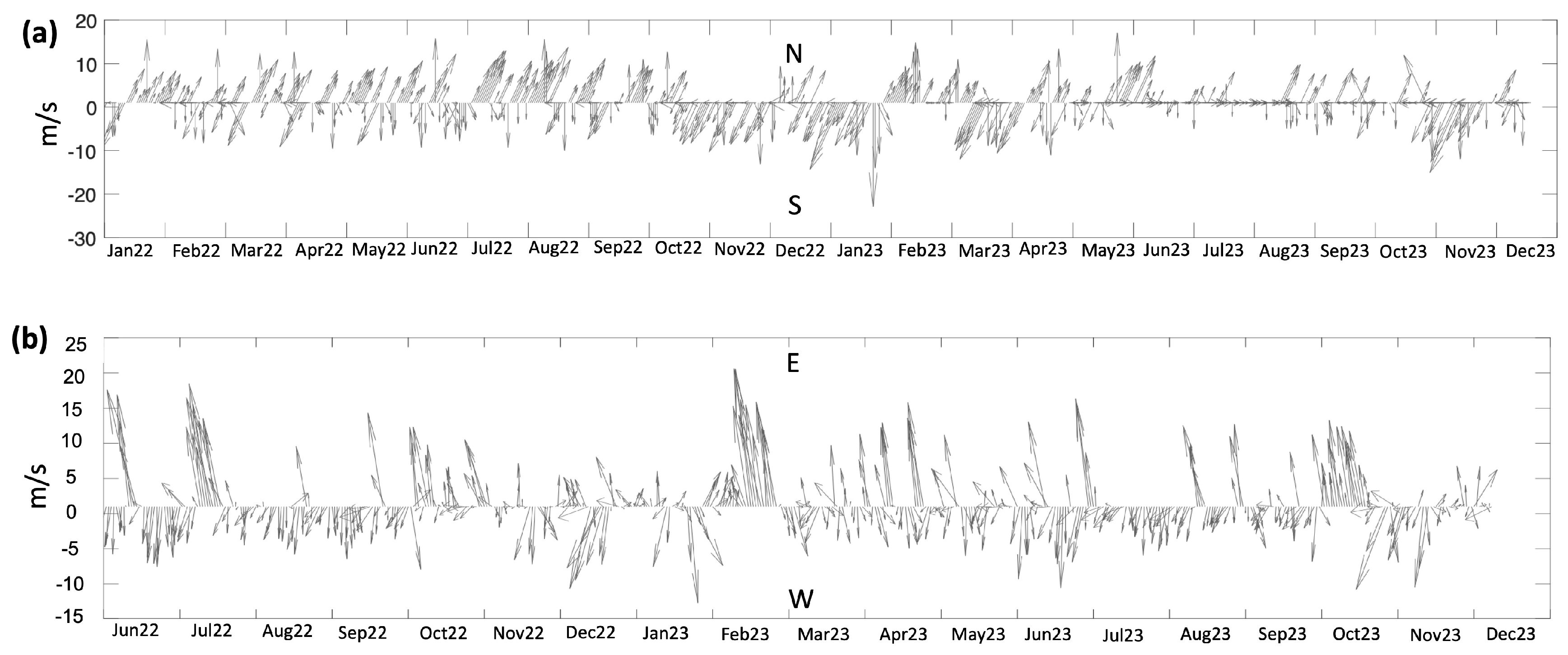

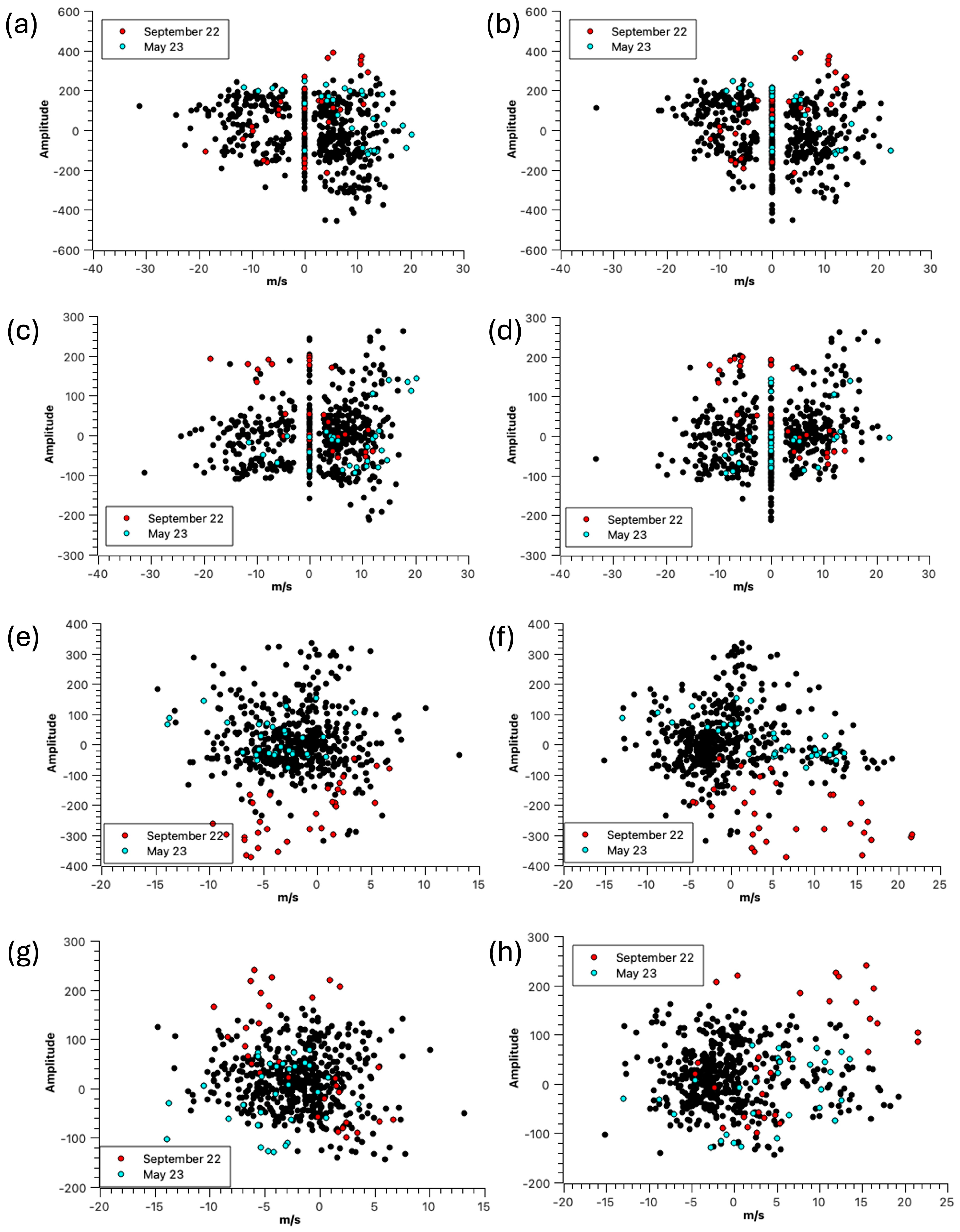

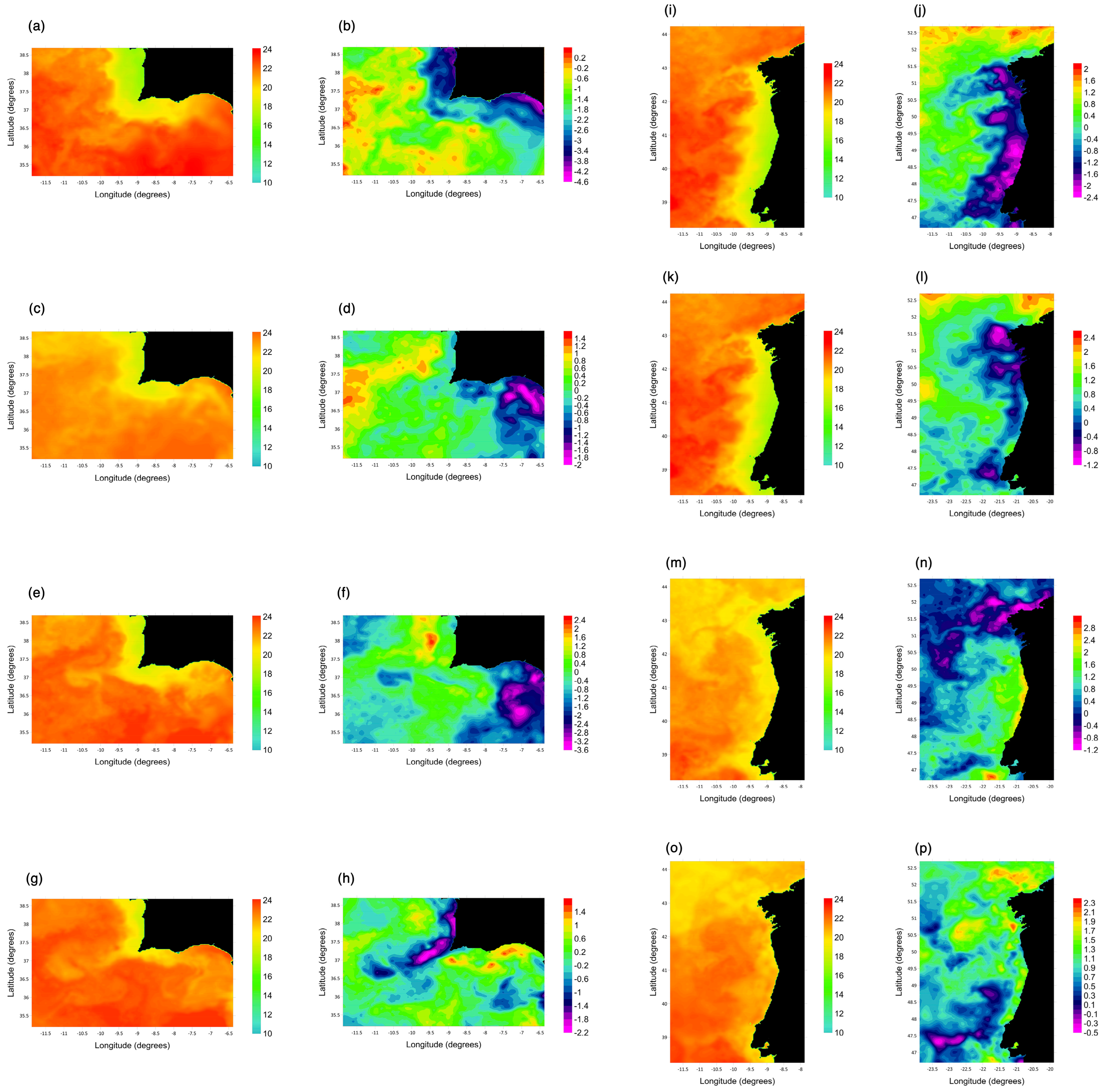
| Order | Galician–Portugal (%) |
|---|---|
| 1 | 95.03 |
| 2 | 2.19 |
| 3 | 0.6 |
| 4 | 0.42 |
| Order | Gulf of Cádiz (%) |
|---|---|
| 1 | 94.81 |
| 2 | 1.77 |
| 3 | 0.88 |
| 4 | 0.41 |
| Wind Component | Month | Correlation |
|---|---|---|
| Along-shore | September 2022 | 0.9564 |
| Along-shore | May 2023 | 0.8736 |
| Cross-shore | September 2022 | 0.9566 |
| Cross-shore | May 2023 | 0.8716 |
| Wind Component | Month | Correlation |
|---|---|---|
| Along-shore | September 2022 | 0.9989 |
| Along-shore | May 2023 | 0.999 |
| Cross-shore | September 2022 | 0.9188 |
| Cross-shore | May 2023 | 0.9079 |
| Wind Component | Mode 2 | Mode 3 | |
|---|---|---|---|
| Galician–Portugal | Along-shore Cross-shore | 0.4446/0.4966 0.5639/0.5836 | 0.5945/0.2137 0.6346/0.1573 |
| Gulf of Cádiz | Along-shore Cross-shore | 0.9314/0.1108 0.8908/0.5724 | 0.5273/0.1012 0.4371/0.2026 |
Disclaimer/Publisher’s Note: The statements, opinions and data contained in all publications are solely those of the individual author(s) and contributor(s) and not of MDPI and/or the editor(s). MDPI and/or the editor(s) disclaim responsibility for any injury to people or property resulting from any ideas, methods, instructions or products referred to in the content. |
© 2024 by the authors. Licensee MDPI, Basel, Switzerland. This article is an open access article distributed under the terms and conditions of the Creative Commons Attribution (CC BY) license (https://creativecommons.org/licenses/by/4.0/).
Share and Cite
del Rosario, J.J.A.; Gómez, E.B.; Pérez, J.M.V.; Rey, F.M.; Silva-Ramírez, E.L. A New Insight on the Upwelling along the Atlantic Iberian Coasts and Warm Water Outflow in the Gulf of Cadiz from Multiscale Ultrahigh Resolution Sea Surface Temperature Imagery. J. Mar. Sci. Eng. 2024, 12, 1580. https://doi.org/10.3390/jmse12091580
del Rosario JJA, Gómez EB, Pérez JMV, Rey FM, Silva-Ramírez EL. A New Insight on the Upwelling along the Atlantic Iberian Coasts and Warm Water Outflow in the Gulf of Cadiz from Multiscale Ultrahigh Resolution Sea Surface Temperature Imagery. Journal of Marine Science and Engineering. 2024; 12(9):1580. https://doi.org/10.3390/jmse12091580
Chicago/Turabian Styledel Rosario, José J. Alonso, Elizabeth Blázquez Gómez, Juan Manuel Vidal Pérez, Faustino Martín Rey, and Esther L. Silva-Ramírez. 2024. "A New Insight on the Upwelling along the Atlantic Iberian Coasts and Warm Water Outflow in the Gulf of Cadiz from Multiscale Ultrahigh Resolution Sea Surface Temperature Imagery" Journal of Marine Science and Engineering 12, no. 9: 1580. https://doi.org/10.3390/jmse12091580






